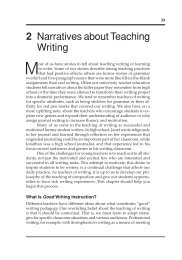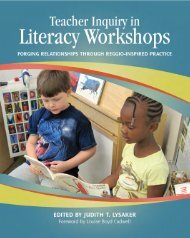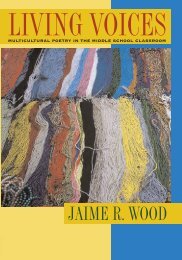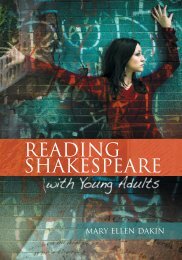Graphic novel Spread - National Council of Teachers of English
Graphic novel Spread - National Council of Teachers of English
Graphic novel Spread - National Council of Teachers of English
- No tags were found...
You also want an ePaper? Increase the reach of your titles
YUMPU automatically turns print PDFs into web optimized ePapers that Google loves.
12 James Bucky Carter<br />
visual actions, objects, and/or symbols, natural or man-made,<br />
that are [encountered] in [the] environment. Through the creative<br />
use <strong>of</strong> these competencies, [we are] able to communicate with<br />
others. Through the appreciative use <strong>of</strong> these competencies, [we<br />
are] able to comprehend and enjoy the masterworks <strong>of</strong> visual<br />
communications (Fransecky & Debes, 1972, p. 7). (http://www.<br />
ivla.org/, 2003)<br />
Mostly, visual literacy has been tied to the fields <strong>of</strong> graphic design, art,<br />
and art history, but, over the last few decades, visual literacy, cultural<br />
literacy, and critical literacy have become more and more intertwined.<br />
Consider NCTE’s recent statement on multimodal literacies (http://<br />
www.ncte.org/about/over/positions/category/media/123213.htm),<br />
which makes it clear that <strong>English</strong> teachers can no longer disregard the<br />
visual. Miles Myers foretold this in 1996:<br />
<strong>English</strong> studies should include translations from one sign system<br />
to another as an essential part <strong>of</strong> the curriculum. These should<br />
include translating words into action—“acting out” scenes from<br />
stories, poems, and dramas—and <strong>novel</strong>s to films, reports to<br />
speeches, paintings to descriptions. This means that students in<br />
<strong>English</strong> need to begin to give substantially more attention to various<br />
media. (p. 191)<br />
Now we must heed his words more than ever (see Peggy Albers’s<br />
“Imagining the Possibilities in Multimodal Curriculum Design” in <strong>English</strong><br />
Education [January 2006] for an explication <strong>of</strong> this Myers quote and<br />
more discussion <strong>of</strong> multimodalities).<br />
The contemporary view <strong>of</strong> literacy, then, is changing such that<br />
texts are no longer considered simply words on a page, but anything in<br />
the surrounding world <strong>of</strong> the literate person. And the literate person is<br />
one who can “read” these various texts, whether written or visual, one<br />
who can read the word and the world (Freire & Macedo, 1987).<br />
Sequential art scholars Scott McCloud (1999), Chris Murray<br />
(1997), and Neil Cohn (2003) have explored visual literacy in relation<br />
to comics and graphic <strong>novel</strong>s. Cohn espouses a theory <strong>of</strong> visual language<br />
that echoes the underpinnings <strong>of</strong> critical and visual literacy. By examining<br />
sequence images, such as those seen in the panel breakdowns <strong>of</strong><br />
comics and graphic <strong>novel</strong>s, Cohn believes one can see a “dynamic and<br />
hierarchical thought process—just like in language” (www.emaki.net,<br />
2003). Essentially, he says that “‘images in sequence’ are actually a language<br />
. . . the same as words in sequence.” Obviously, the graphic <strong>novel</strong><br />
can <strong>of</strong>fer a rich and stimulating means by which to develop the visual<br />
literacy <strong>of</strong> students. As more research on dual coding develops, sequen-
















